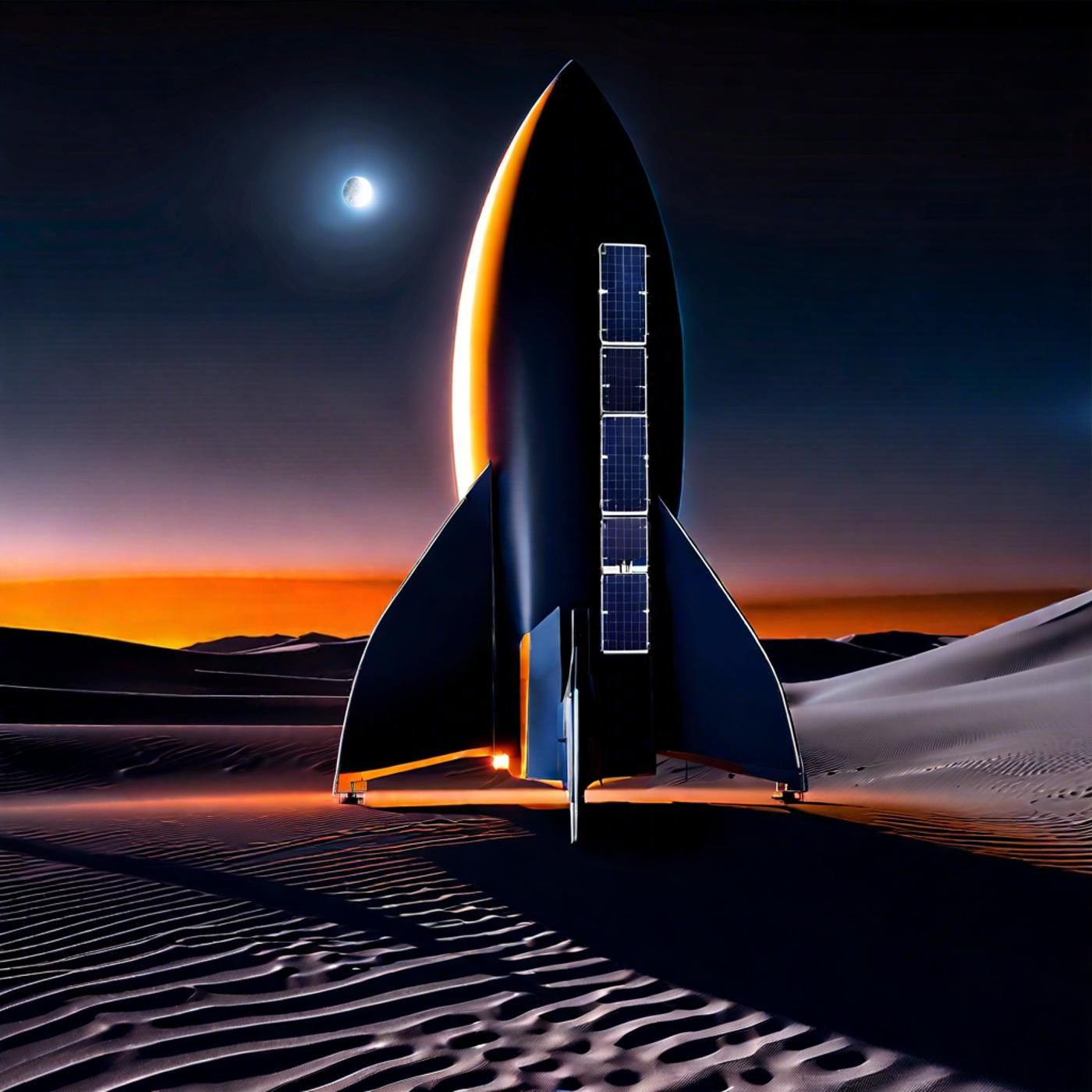S03E94: SpaceX's Starship Milestones & Webb's Spiral Galaxy Revelation
Welcome to Astronomy Daily, your go-to podcast for the latest news and updates from the fascinating world of astronomy and space exploration. I'm your host, Anna, and I'm thrilled to have you with us today.We've got a lineup of exciting stories that...
Welcome to Astronomy Daily, your go-to podcast for the latest news and updates from the fascinating world of astronomy and space exploration. I'm your host, Anna, and I'm thrilled to have you with us today.We've got a lineup of exciting stories that span from groundbreaking missions to the cutting-edge technology shaping our future in space.In today's episode, we're diving into SpaceX's preparations for the fifth flight of its revolutionary Starship program, including heat shield upgrades and static fire tests. We'll also explore groundbreaking discoveries from the James Webb Space Telescope, revealing that spiral galaxies were more common in the early universe than previously believed. Next, we'll look at China's Tiangong space station, where astronauts recently completed a successful spacewalk to install space debris protection. Finally, we'll delve into advancements in CubeSat propulsion technologies, breaking down various systems and their potential impact on space exploration.So sit back, relax, and let's embark on this cosmic adventure together.
Don't forget to visit our website at astronomydaily.io, where you can stay up to date with the latest space news through our continually updating news feed. There, you'll also find additional resources and the full archive of our podcast episodes available for streaming anytime. Stay curious, keep looking to the stars, and make sure to tune in next time for more cosmic insights and adventures. Until then, this is Anna signing off. Clear skies and happy stargazing.
https://www.astronomydaily.io
https://www.bitesz.com
Support our sponsor...NordVPN who helped make this episode possible. Get our special deal at www.bitesz.com/nordvpn
Become a supporter of this podcast: https://www.spreaker.com/podcast/astronomy-daily-the-podcast--5648921/support.
Today's Astronomy Daily includes news from the world of space exploration
Anna: welcome to Astronomy Daily. I'm your host, Anna. Today we have an exciting lineup of news from the world of space exploration. We'll kick things off with updates on SpaceX's starship preparations, then delve into groundbreaking discoveries from the James Webb space Telescope. Up next, we'll explore the latest achievements from China's Tiangong space station, including a recent spacewalk. And finally, we'll look at some fascinating advancements in cubesat propulsion technologies. Let's dive into the cosmos and see what's happening out there.
SpaceX is making significant progress on preparations for the fifth starship flight
M SpaceX is making remarkable progress on preparations for the fifth flight of its revolutionary starship program. One of the major tasks they're focusing on is replacing the heat shield on ship 30. Over the past few weeks, they've been adding new ablative material and stronger tiles to the ship. The tank sections now feature four layers of material, along with a carbon fiber material called Pyron, which acts as an extra layer of protection just in case the primary heat shield fails. In addition to the work on ship 30, SpaceX is gearing up for a static fire test of booster twelve. This booster has been in megabay one since January and could be rolled out as early as July 8 or nine. However, with hurricane barrel posing a threat, this could be delayed if highway four gets flooded. SpaceX has already requested closures for testing on July 9, ten and eleven, during which booster twelve will undergo a AH 33 engine static fire test. While these immediate tasks are critical, SpaceX is also making significant strides in long term planning, particularly with orbital launchpad b. The first tower module has been rolled out to the launch site, although it's yet to be stacked as corner adapters are being prepared, notably in a different approach from the original tower next door. Pad b will be a hollow steel structure filled with concrete, adding strength and protection from exhaust during launches. Teams have already integrated commodities lines and cryogenic propellant lines inside the modules before rolling them to the launch site, streamlining the assembly process. Progress doesn't stop there. At the orbital launch pad a, SpaceX has removed the old vertical tanks from the orbital tank farm and has switched fully to horizontal tanks since flight four. They have two new liquid methane tanks stored at Sanchez, which might be moved to the open space to enhance capacity. This is a crucial step as, uh, SpaceX plans to tie this tank farm into orbital launch pad b once the tower and mount are completed. Moreover, SpaceX continues to refine its technology. Ship 31, for instance, rolled back to masseys for cryo testing after undergoing repairs from a small explosion and electrical fire. Its readiness for static fire testing could come as soon as two to three months, provided it doesn't need a complete heat shield replacement like Ship 30. These meticulous preparations and upgrades clearly indicate that SpaceX is pulling out all the stops to ensure the success of their starship program. When Elon Musk mentioned during Tim Dodds Starbase tour that the new tower would be taller than the one at pad A, the ambition was clear. Even though the FAA has set mid August as the target for completing this new tower, the reality may extend a bit further. Overall, SpaceX's recent efforts showcase a ah combination of immediate focus areas and well strategized long term plans, setting the stage for future missions and their ultimate goal of making life.
Researchers using NASA's James Webb Space Telescope have made a surprising discovery
M multiplanetary astronomers using NASA's James Webb Space Telescope have made a surprising discovery that is rewriting our understanding of cosmic history. They found that spiral galaxies were more common in the early universe than previously believed. This revelation challenges earlier assumptions about the timeline of galaxy formation and suggests that the process occurred much faster than we thought for a long time. Scientists believe that most spiral galaxies, including our own Milky Way, developed around six to 7 billion years after the universe formed. However, new research from the University of Missouri reveals that these galaxies were already prevalent as early as 2 billion years after the universe's inception. This groundbreaking finding indicates a much quicker rate of galaxy formation and evolution. This insight is crucial because it provides a more comprehensive picture of how spiral galaxies like the Milky Way came to be. Understanding when and how these galaxies formed helps astronomers piece together the broader history and evolution of the cosmos. The study shows that about 30% of galaxies had spiral structures just 2 billion years after the universe began, which is a significant increase from previous estimates. The advanced technology of the James Webb Space Telescope has been instrumental in making these observations. With its ability to capture detailed images of distant galaxies, JWST allows scientists to peer back in time and study the early universe with unprecedented clarity. This new data helps researchers solve cosmic puzzles and deepens our understanding of the physical processes that shaped the universe. In essence, these findings not only challenge our previous notions, but also open up new avenues for exploring the nature of galaxy formation and the history of our universe. As we continue to analyze data from JWST, we can expect more revelations that will further expand our knowledge and reshape our cosmic timeline.
Two chinese astronauts conducted a successful spacewalk outside the Tiangong
Two chinese astronauts from the Shenzhou 18 mission have recently conducted a successful spacewalk outside the Tiangong space station, marking another significant milestone in China's space exploration efforts. Yeguangfu and Lee Kong spent about 6.5 hours working outside Tiangong, focusing primarily on installing space debris protection. Their task was vital for enhancing the space station's long term operational stability. Space debris poses a significant threat to orbiting spacecraft, and this protection helps mitigate the risk. Utilizing the station's robotic arm, operated by their colleague Lee Guangzhou from inside Tiangong, they managed to efficiently place the protective devices around critical extravehicular equipment, mainly focusing on cables and pipelines. Beyond the installation, the astronauts also conducted a thorough extravehicular inspection of the space station's facilities, capturing detailed visuals through Lee Kong's helmet camera. This inspection is crucial for ongoing maintenance and ensuring all systems function optimally. This wasn't the first spacewalk for the Shenzhou 18 crew in a previous eva. In late May, Ye Guangfu and Lee Guangzhou set a national record by spending about 8.5 hours outside the space station, reinforcing space debris protection on the Mengtian experiment module. Reflecting on the experience, Lee Kong expressed a deep sense of pride and awe. Uh, he mentioned how the space station looked incredibly beautiful, especially when viewed from the highest point of the robotic arm, despite the glaring sunlight. This sentiment underscores the monumental achievements of China's space program and the dedication of all involved. With 16 spacewalks completed outside Tiangong and 17 astronauts participating in these evas, China's Tiangong program continues to advance, marking significant progress in their manned spaceflight capabilities. As we continue to monitor the developments from Tiangong, it's clear that each mission builds upon the legacy of those before it, propelling humanity further into the final frontier.
A recent review from Khalifa University has categorized various propulsion technologies for cubesats
Cubesats are becoming a popular tool for space exploration. These small but powerful satellites are making significant contributions to our understanding of space. However, one notable challenge that's been limiting their potential is propulsion. A recent review from Khalifa University has categorized various propulsion technologies for cubesats, breaking them down into chemical, kinetic, electrical, and propellantless systems. Let's start with chemical propulsion. These are the traditional rockets that most of us picture when we think of space travel. They rely on burning chemicals together to create thrust. While effective, the bulkiness of these systems often makes them unsuitable for cubesats. Despite advances in miniaturization, chemical propulsion systems are still cumbersome for this application. Next up, we have kinetic systems, which are more suited for cubesats. These include setups like cold gas thrusters, which expel non reacting gas to generate propulsion. If the gas is heated slightly before being released, it transforms into what is known as a resistojet system. Both types offer a simpler, more compact alternative to chemical propulsion, though they're still less efficient compared to their large scale counterparts. Moving on to electrical propulsion, these systems offer more efficient thrust but are more complex to implement. They typically use electric energy to heat propellants before expelling them. There are three main electrothermal discharge systems, which are akin to advanced arc jets electrostatic systems, which use electrical forces to accelerate charged particles, and electromagnetic systems, which use magnetic fields to push out ionized propellant. While promising, these systems often require high precision manufacturing, making them somewhat tricky for widespread use in cubesats. Lastly, there are propellant list technologies which have gained attention with projects like the planetary society's light sail. These systems rely on external forces, such as solar sails harnessing sunlight to move cubesats. Though they offer the potential for near limitless thrust, they also face challenges in material development and space constraints. So while cubesats are coming into their own, the journey towards optimal propulsion continues. Whoever cracks this puzzle will undoubtedly make significant strides in space exploration.
This week's Astronomy Daily includes updates on SpaceX, the Webb telescope
That's it for today's episode of Astronomy Daily. I hope you found our updates on SpaceX, the Webb telescope, China's Tiangong station, and CubeSat technologies. As fascinating as I did, don't forget to visit our website at astronomydaily dot IO for all our podcast episodes and the latest space news. You can also follow us on Facebook X and TikTok for more updates. Until next time, keep looking up,
New to Astronomy Daily - The Podcast?
Here are some great episodes to start with.



















